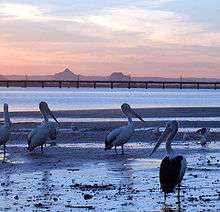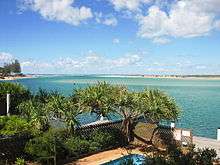Pumicestone Passage



Pumicestone Passage, also known as the Pumicestone Channel, is a narrow waterway between Bribie Island and the mainland in Queensland, Australia. The northern extent of the passage is at Caloundra, while at the south is Deception Bay.
History
The passage was originally shown as Pumice-stone River on the maps of Matthew Flinders as he found an abundance of pumice stone lining the shoreline. He was the first European explorer to enter Moreton Bay in 1799 on the Sloop H. M. 'Norfolk' and spent two weeks exploring the bay and surrounds and naming Point Skirmish and Pumice-stone River. [1]
Environment
Gazetted in 1986, Pumicestone Passage Marine Park, extends from the southern entrance to the Caloundra bar and is just over 35 kilometres long via the channels and has a surface area of 63 km². The marine park has 24 islands and is bounded by 240 kilometres of shoreline. Eighty percent of the Passage is under two metres deep and dugongs frequent its waters seasonally to feed on the seagrass on the bottom of the channels in the passage. Dolphins and turtles also make the Passage home as do over 350 species of birds. Habitats within and adjoining the passage include mangroves and saltmarshes, sand flats and mud flats, coastal dunes and seagrass meadows.[2] [3] [4] The Passage forms part of the Moreton Bay and Pumicestone Passage Important Bird Area, so identified by BirdLife International because it supports large numbers of migratory waders, or shorebirds.[5]
See also
References
- ↑ The Matthew Flinders Bicentenary Association
- ↑ Bridie Island Tourist Information
- ↑ Victoria Education website
- ↑ Queensland things to do website
- ↑ "IBA: Moreton Bay and Pumicestone Passage". Birdata. Birds Australia. Retrieved 2011-08-17.
Coordinates: 26°56′22″S 153°04′11″E / 26.9394°S 153.0698°E